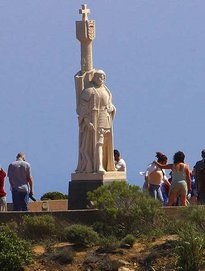Juan Rodriguez Cabrillo
|
|
Juan Rodríguez Cabrillo (in Spanish, also known by the Portuguese version João Rodrigues Cabrilho) (ca. 1499 – January 3, 1543) was a Portuguese explorer noted for his exploration of the west coast of North America while sailing for Spain. Cabrillo was the first European explorer to navigate the coast of present day California in the United States. He also helped found the city of Oaxaca, Oaxaca, in Mexico.
| Contents |
Origins
Little is known about Cabrillo’s early years. Even his nationality is uncertain; most biographies describe him as Portuguese, but in his exhaustive 1986 biography Juan Rodriguez Cabrillo, historian Harry Kelsey writes that Cabrillo appears to have been born in Spain, "probably in Seville, but perhaps in Cuellar." His date of birth and parentage are also unknown, but events in Cabrillo’s life lead Kelsey to believe he was born of poor parents "around 1498 or 1500," and then worked for his keep in the home of a prominent Seville merchant.
Voyages
Rodríguez Cabrillo shipped for Havana as a lad and joined the forces of Hernán Cortés in Mexico. Later, his entrepreneurial skills, enslaving the natives of his landholdings to mine gold in Guatemala, made him one of the richest of the conquistadors in Mexico.
Following the 1539 voyage of Francisco de Ulloa, who had been commissioned by Hernán Cortés and had discovered the Gulf of California, reaching as far the 28th parallel, Cabrillo was commissioned by the viceroy of New Spain, Antonio de Mendoza, to lead an expedition up the Pacific coast in search of trade opportunities, perhaps to find a way to China, for the full extent of the northern Pacific was still unrealized, or the mythical Strait of Anián that supposedly connected the Pacific Ocean to Hudson Bay, providing a route for the Northwest Passage. Cabrillo, who had started life as a shipbuilder's boy, had built and owned the flagship of his venture (two or three ships), and stood to profit from any trade or treasure.
On June 27, 1542, Cabrillo set out from Navidad (now Acapulco) in New Spain. On September 28, 1542, he landed in what is now San Diego Bay and named it "San Miguel". Going up the coast, he sailed through the Santa Barbara Channel and around Point Conception, eventually sailing as far north as the Russian River before autumn storms forced them to turn back. On November 23, 1542, the little fleet limped back to "San Salvador" (Santa Catalina Island) to overwinter and make repairs. There Cabrillo stepped out of his boat and splintered his shin when he stepped on a jagged rock. The injury developed gangrene and he died on January 3, 1543 and was buried. His second-in-command brought the remainder of the party back to Navidad, where they arrived April 14, 1543.
A notary's official report of Cabrillo's inconclusive expedition was lost; all that survives is a summary of it made by another investigator, Andrés de Urdaneta, who also had access to ships' logs and charts. No printed account of Cabrillo's voyage appeared in print before historian Antonio de Herrera's account early in the 17th century.
The final mystery about Cabrillo is his place of burial. He died on January 3, 1543 off the coast of southern California, but his burial site is unknown; Santa Catalina Island, San Miguel Island and Santa Rosa Island have all been suggested.
Legacy
Although his discoveries went largely unnoticed at the time, none of his place names were permanently adopted, and he founded no settlements on the well-populated coast, Cabrillo is now remembered as the first European to travel the California coast, and many streets and buildings in California bear his name. One such example is Cabrillo College in Aptos, California, another is the portion of the Pacific Coast Highway 1 that runs through Big Sur, which is also called the Cabrillo Highway. In San Diego, the National Park Service operates a monument, Cabrillo National Monument, overlooking the bay at Point Loma commemorating his first landing in California and offering views of both San Diego and the Pacific Ocean.
External links
- Albert Greenstein's brief biography of Cabrillo (http://www.socalhistory.org/Biographies/cabrillo.htm)
- Cabrillo National Monument (http://www.nps.gov/cabr/)

